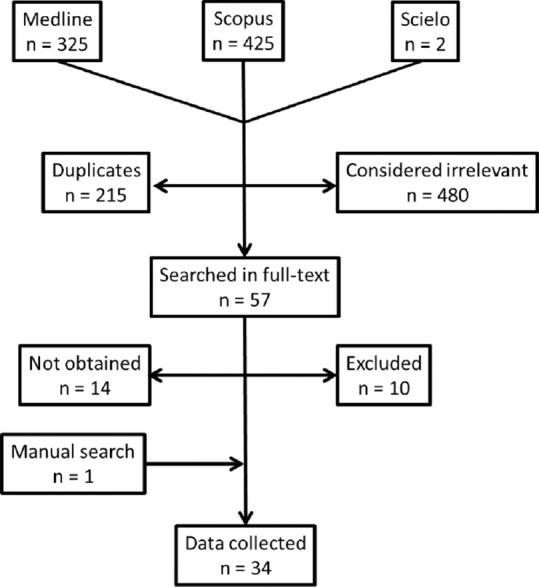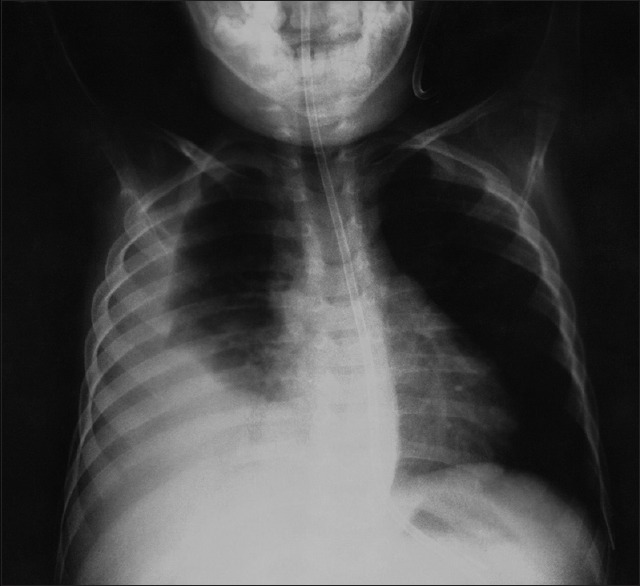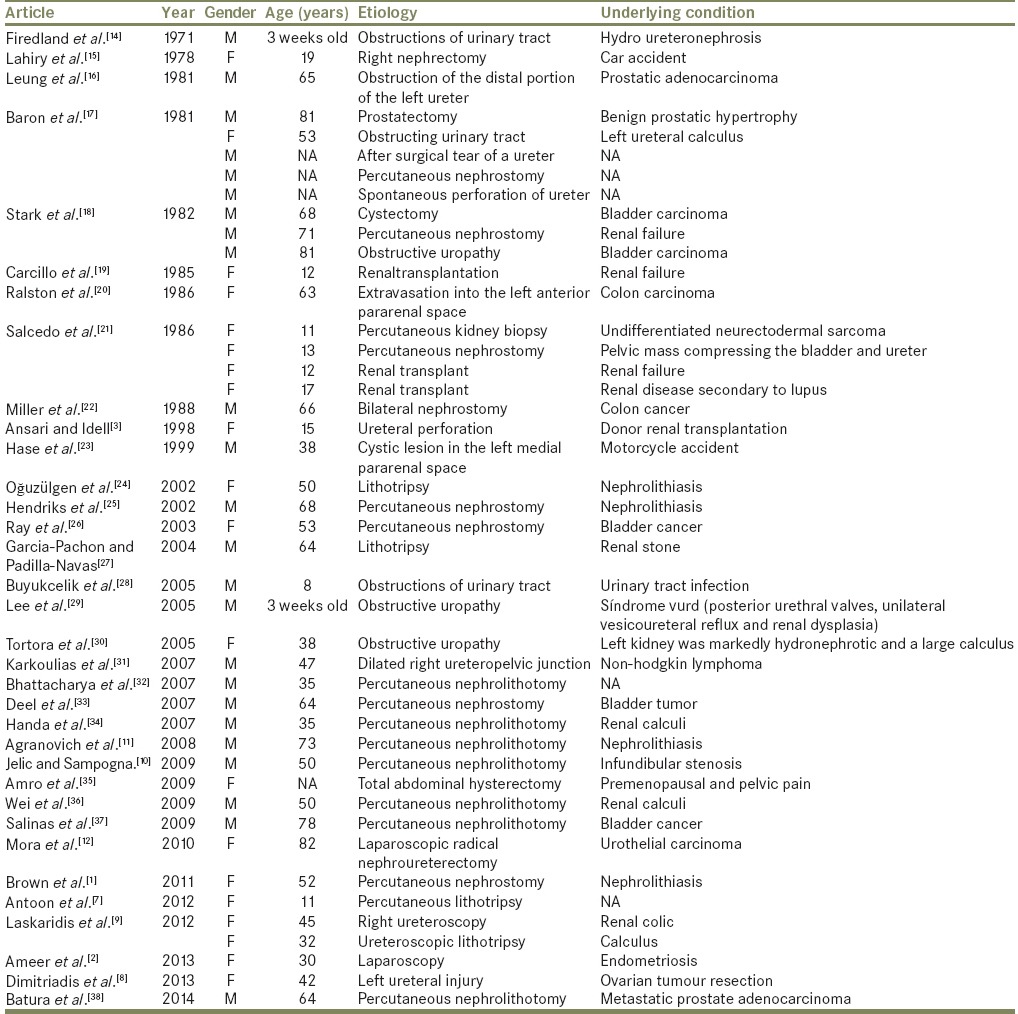Abstract
Urinothorax, the presence of urine in the pleural space, is a rare cause of pleural effusion, usually associated with obstructive uropathy, or urinary trauma. We present the case of a 3 year-old boy and a systematic review of the literature of the 44 cases encountered. After resection of a Wilm's tumour in the right kidney our patient presented acute respiratory distress associated with radiographically confirmed pleural effusion. With the initial diagnosis of pneumonia or malignant pleural effusion, a closed thoracotomy was performed. The liquid obtained suggested urine, which was confirmed by the laboratory. Cystoscopy with retrograde pyelography detected a fistula on the posterior wall of the right kidney. The report of cases worldwide is low, probably due to its low incidence but also to underdiagnosis. Respiratory symptoms are not always present and urological symptoms usually predominate. Diagnosis requires a high degree of clinical suspicion and is confirmed by the main biochemical marker: The ratio >1.0 pleural fluid creatinine and creatinine serum.
Keywords: Pleural effusion, urinothorax, urologic surgical procedures, Wilms tumor
INTRODUCTION
Urinothorax is a rare cause of pleural effusion in patients with obstructive or traumatic uropathy.[1,2,3,4,5] It has been reported in patients with blunt trauma or after abdominal surgical procedures.[6] Disruption of the urinary tract leads to accumulation of urine in the retroperitoneal space that leaks into the pleural space.[5,7] It is usually ipsilateral to the lesion side.[8,9] Diagnosis can be done with renal scintigraphy with a radioactive tracer,[10,11] or measuring creatinine levels in pleural fluids.[12] Frequently reported in adults; we present the case of a 3-year-old boy and a systematic review of the literature.
CASE REPORT
A 3-year-old boy was admitted for surgical treatment of Wilm's tumor in the right kidney. The patient had a history of chronic kidney disease, secondary hypertension and had undergone a left nephrectomy 2 years before due to the same condition. The surgical procedure, partial nephrectomy with total resection of the tumor and suture of the renal pelvis, was uneventful. Central venous and peritoneal catheters were placed. On postoperative day 3 the patient developed acute respiratory distress, and a chest X-ray revealed right pleural effusion, which affected two-thirds of the right hemithorax [Figure 1]. Diagnoses of pneumonia and parapneumonic effusion were considered. A thoracostomy was performed, and 1,050 ml of yellowish color liquid were drained during the following 20 h, during which he also developed oliguria and fever. He received treatment with antibiotics (meropenem and vancomycin). The aspect and particularly, the smell of pleural liquid oriented the diagnosis of urinothorax. The ratio of creatinine levels in pleural fluid and blood was 4.8, which was highly suggestive of urine. Excretory urography was not performed due to the high risk of inducing renal failure.
Figure 1.

Systematic review flowchart
Cystoscopy with retrograde pyelography showed a low flow fistula on the posterior wall of the right renal calyx. A ureteral catheter was placed during the surgical closure of the fistula, and nutritional support was initiated, 3 days after thoracotomy pleural effusions disappeared. Pathology confirmed contralateral Wilm's tumor (grade 5). He remained with the ureteral catheter 6 months until achieving complete closure of the fistula and was asymptomatic on last clinical control, 3 months later.
METHODS
We performed a systematic review of the literature, following a standard methodology[13] in three databases (PubMed, Scopus and Scielo, a Latin American database), using “pleural effusion” and “urine” as free terms, with no language or time limits. A thorough review process ended up with a total of 752 references [Figure 2], 23 of which were published before 1998 (of which only 9 were located and retrieved full-text).[14,15,16,17,18,19,20,21,22] Of the 57 articles in full-text, ten were excluded because they were not cases of urinothorax.
Figure 2.

Chest radiography of a 3-year-old boy with right pleural effusion
RESULTS
The 34 case reports we analyzed described a total of 44 patients [Table 1], 24 of which were male. Age ranged from to 3 weeks of age to 82 years old (mean 44, standard deviation ± 25, median 49). Only 10 were children (<18 years). Among the most common underlying conditions were: Neoplasms (n = 14), nephrolithiasis (n = 9), gynecological diseases (n = 2), car accident (n = 2), renal failure (n = 4), and with one each, vesicoureteral reflux and renal dysplasia (VURD) syndrome (posterior urethral valves, unilateral VURD), benign prostatic hypertrophy, hydroureteronephrosis, urinary tract infection, Infundibular stenosis, donor renal transplantation, renal colic, pelvic pain and not available (n = 5).
Table 1.
Clinical characteristics of patients with urinothorax described in the literature (n=44)

Urinothorax was associated with surgical procedures in most patients: Nephrostomy (n = 15), urethral obstruction (n = 10), transplantation (n = 4), lithotripsy (n = 4), nephrectomy (n = 2), prostatectomy, ureteroscopy, combined hysterectomy and salpingo-oophorectomy, trauma (one each), and other surgery (n = 5).
DISCUSSION
Urinothorax should be included in the differential diagnosis of pleural effusions in patients of any age subjected to gynecological, urological surgical procedures as well as resections of intraperitoneal tumors.[19,23,31] Most of the case reports reviewed emphasize urinothorax as an unexpected surprise. Despite being a rare condition, most large adult or pediatric urological departments should expect to see one of these cases.
Respiratory symptoms are evident in some patients but are not always present, and may be wrongly attributed to atelectasis or pneumonia.[8] Biochemical testing is useful, and the ratio of creatinine and biochemical analysis of pleural fluid confirms the diagnosis.[5,19] Diagnostic imaging, renal scan, X-ray, contrast-enhanced computed tomography or pyelogram are essential to establish the anatomical location of the defect causing urine leakage.[24,36]
In our case, contrast means were not indicated, given that the patient had renal failure, but cystoscopy plus pyelogram in the operating room showed the atomic location of the fistula.
Initial management of urinothorax is with toracocentesisis or thoracostomy[37] but detecting the origin of the leakage and performing surgical repair is essential. As a conclusion, urinothorax is a rare complication, but should be held in mind, since an early diagnosis will improve the patient's outcome.[38]
Footnotes
Source of Support: Nil
Conflict of Interest: None.
REFERENCES
- 1.Brown B, Trotter C, Cox P, Hanlon C. Urinothorax: A rare cause of pleural effusion. W V Med J. 2011;107:16–7. [PubMed] [Google Scholar]
- 2.Ameer KA, Thomas R, Sureshkumar VK, Deepak V, Srikanth P, Arjun P, et al. An unusual complication of a common gynaecological procedure. J Assoc Physicians India. 2012;61:490–2. [PubMed] [Google Scholar]
- 3.Ansari T, Idell S. Management of undiagnosed persistent pleural effusions. Clin Chest Med. 1998;19:407–17. doi: 10.1016/s0272-5231(05)70087-3. [DOI] [PubMed] [Google Scholar]
- 4.Bramley K, Puchalski JT. Defying gravity: Subdiaphragmatic causes of pleural effusions. Clin Chest Med. 2013;34:39–46. doi: 10.1016/j.ccm.2012.12.004. [DOI] [PubMed] [Google Scholar]
- 5.Garcia-Pachon E, Romero S. Urinothorax: A new approach. Curr Opin Pulm Med. 2006;12:259–63. doi: 10.1097/01.mcp.0000230628.65515.86. [DOI] [PubMed] [Google Scholar]
- 6.Kees-Folts D, Cole BR. Ureteral urine leak presenting as a pleural effusion in a renal transplant recipient. Pediatr Nephrol. 1998;12:666–7. doi: 10.1007/s004670050525. [DOI] [PubMed] [Google Scholar]
- 7.Antoon JW, Knudson-Johnson M, Kiernan MP. An unusual case of pediatric shortness of breath–answers. Pediatr Nephrol. 2012;27:923–5. doi: 10.1007/s00467-011-2012-9. [DOI] [PubMed] [Google Scholar]
- 8.Dimitriadis G, Tahmatzopoulos A, Kampantais S, Ioannidis S, Radopoulos D, Katsikas V. Unilateral urinothorax can occur contralateral to the affected kidney. Scand J Urol. 2013;47:242–3. doi: 10.3109/00365599.2012.695391. [DOI] [PubMed] [Google Scholar]
- 9.Laskaridis L, Kampantais S, Toutziaris C, Chachopoulos B, Perdikis I, Tahmatzopoulos A, et al. Urinothorax-an underdiagnosed cause of acute dyspnea: Report of a bilateral and of an ipsilateral urinothorax case. Case Rep Emerg Med 2012. 2012:1–3. doi: 10.1155/2012/395653. [DOI] [PMC free article] [PubMed] [Google Scholar]
- 10.Jelic S, Sampogna R V. Detection of unrecognized urinothorax with renal scintigraphy. Kidney Int. 2009;76:353. doi: 10.1038/ki.2009.149. [DOI] [PubMed] [Google Scholar]
- 11.Agranovich S, Cherniavsky E, Tiktinsky E, Horne T, Lantsberg S. Unilateral urinothorax due to nephropleural fistula detected on Tc-99m diethylenetriamine pentaacetic acid renal scintigraphy. Clin Nucl Med. 2008;33:889–91. doi: 10.1097/RLU.0b013e31818bf181. [DOI] [PubMed] [Google Scholar]
- 12.Mora RB, Silvente CM, Nieto JMS, Cuervo MAC. Urinothorax: Presentation of a new case as pleural exudate. South Med J. 2010;103:931–3. doi: 10.1097/SMJ.0b013e3181e9a38a. [DOI] [PubMed] [Google Scholar]
- 13.Alsaywid BS, Smith GH. Antibiotic prophylaxis for transurethral urological surgeries: Systematic review. Urol Ann. 2013;5:61–74. doi: 10.4103/0974-7796.109993. [DOI] [PMC free article] [PubMed] [Google Scholar]
- 14.Friedland GW, Axman MM, Love T. Neonatal “urinothorax” associated with posterior urethral valves. Br J Radiol. 1971;44:471–4. doi: 10.1259/0007-1285-44-522-471. [DOI] [PubMed] [Google Scholar]
- 15.Lahiry SK, Alkhafaji AH, Brown AL. Urinothorax following blunt trauma to the kidney. J Trauma. 1978;18:608–10. doi: 10.1097/00005373-197808000-00010. [DOI] [PubMed] [Google Scholar]
- 16.Leung FW, Williams AJ, Oill PA. Pleural effusion associated with urinary tract obstruction: Support for a hypothesis. Thorax. 1981;36:632–3. doi: 10.1136/thx.36.8.632. [DOI] [PMC free article] [PubMed] [Google Scholar]
- 17.Baron RL, Stark DD, McClennan BL, Shanes JG, Davis GL, Koch DD. Intrathoracic extension of retroperitoneal urine collections. AJR Am J Roentgenol. 1981;137:37–41. doi: 10.2214/ajr.137.1.37. [DOI] [PubMed] [Google Scholar]
- 18.Stark DD, Shanes JG, Baron RL, Koch DD. Biochemical features of urinothorax. Arch Intern Med. 1982;142:1509–11. [PubMed] [Google Scholar]
- 19.Carcillo J, Salcedo JR. Urinothorax as a manifestation of nondilated obstructive uropathy following renal transplantation. Am J Kidney Dis. 1985;5:211–3. doi: 10.1016/s0272-6386(85)80053-6. [DOI] [PubMed] [Google Scholar]
- 20.Ralston MD, Wilkinson RH. Bilateral urinothorax identified by technetium-99m DPTA renal imaging. J Nucl Med. 1986;27:56–9. [PubMed] [Google Scholar]
- 21.Salcedo JR. Urinothorax: Report of 4 cases and review of the literature. J Urol. 1986;135:805–8. doi: 10.1016/s0022-5347(17)45862-9. [DOI] [PubMed] [Google Scholar]
- 22.Miller KS, Wooten S, Sahn SA. Urinothorax: t cause of low pH transudative pleural effusions. Am J Med. 1988;85:448–9. doi: 10.1016/0002-9343(88)90610-9. [DOI] [PubMed] [Google Scholar]
- 23.Hase T, Kodama M, Domasu S, Nakamura K, Morita K, Tarumi T, et al. A case of urothorax that manifested as posttraumatic pleural effusion after a motorcycle crash. J Trauma. 1999;46:967–9. doi: 10.1097/00005373-199905000-00037. [DOI] [PubMed] [Google Scholar]
- 24.Oğuzülgen IK, Oğuzülgen AI, Sinik Z, Köktürk O, Ekim N, Karaoğlan U. An unusual cause of urinothorax. Respiration. 2002;69:273–4. doi: 10.1159/000063633. [DOI] [PubMed] [Google Scholar]
- 25.Hendriks J, Michielsen D, Van Schil P, Wyndaele JJ. Urinothorax: A rare pleural effusion. Acta Chir Belg. 2002;102:274–5. doi: 10.1080/00015458.2002.11679314. [DOI] [PubMed] [Google Scholar]
- 26.Ray K, Rattan S, Yohannes T. Urinothorax: Unexpected cause of a pleural effusion. Mayo Clin Proc. 2003;78:1433–4. doi: 10.4065/78.11.1433. [DOI] [PubMed] [Google Scholar]
- 27.Garcia-Pachon E, Padilla-Navas I. Urinothorax: Case report and review of the literature with emphasis on biochemical diagnosis. Respiration. 2004;71:533–6. doi: 10.1159/000080642. [DOI] [PubMed] [Google Scholar]
- 28.Buyukcelik M, Satar N, Celik U, Yildizdas D, Dursun H, Soran M, et al. An unusual cause of pleural effusion, urinothorax in a child with urinary stone disease. Pediatr Nephrol. 2005;20:1487–9. doi: 10.1007/s00467-005-1949-y. [DOI] [PubMed] [Google Scholar]
- 29.Lee CC, Fang CC, Chou HC, Tsau YK. Urinothorax associated with VURD syndrome. Pediatr Nephrol. 2005;20:543–6. doi: 10.1007/s00467-004-1755-y. [DOI] [PubMed] [Google Scholar]
- 30.Tortora A, Casciani E, Kharrub Z, Gualdi G. Urinothorax: An unexpected cause of severe dyspnea. Emerg Radiol. 2006;12:189–1. doi: 10.1007/s10140-006-0468-x. [DOI] [PubMed] [Google Scholar]
- 31.Karkoulias K, Sampsonas F, Kaparianos A, Tsiamita M, Tsoukalas G, Spiropoulos K. Urinothorax: An unexpected cause of pleural effusion in a patient with non-Hodgkin lymphoma. Eur Rev Med Pharmacol Sci. 2007;11:373–4. [PubMed] [Google Scholar]
- 32.Bhattacharya A, Venkataramarao SH, Kumar S, Mittal BR. Urinothorax demonstrated on 99mTc ethylene dicysteine renal scintigraphy. Nephrol Dial Transplant. 2007;22:1782–3. doi: 10.1093/ndt/gfm105. [DOI] [PubMed] [Google Scholar]
- 33.Deel S, Robinette E. Urinothorax: A rapidly accumulating transudative pleural effusion in a 64-year-old man. South Med J. 2007;100:519–21. doi: 10.1097/01.smj.0000242789.87832.24. [DOI] [PubMed] [Google Scholar]
- 34.Handa A, Agarwal R, Aggarwal AN. Urinothorax: An unusual cause of pleural effusion. Singapore Med J. 2007;48:289–92. [PubMed] [Google Scholar]
- 35.Amro O, Webb-Smith F, Sunderji S. Urinothorax: A rare complication of total abdominal hysterectomy. Obstet Gynecol. 2009;114:482–4. doi: 10.1097/AOG.0b013e31819bda90. [DOI] [PubMed] [Google Scholar]
- 36.Wei B, Takayama H, Bacchetta MD. Urinothorax: An uncommon cause of pleural effusion. Respir Med. 2009;2:179–80. [Google Scholar]
- 37.Salinas PJ, Rodríguez F. Urinothorax: Case report and literature review. Rev Med. 2009;17:141–5. [Google Scholar]
- 38.Batura D, Haylock-Vize P, Naji Y, Tennant R, Fawcett K. Management of iatrogenic urinothorax following ultrasound guided percutaneous nephrostomy. J Radiol Case Rep. 2014;8:34–40. doi: 10.3941/jrcr.v8i1.1424. [DOI] [PMC free article] [PubMed] [Google Scholar]


